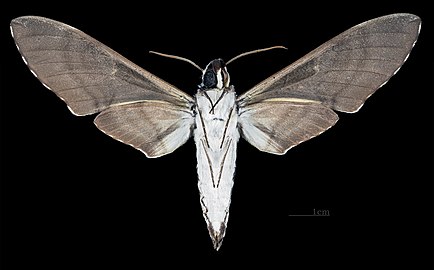
Manduca hannibal is a moth of the family Sphingidae.

Manduca florestan, the Florestan sphinx, is a moth of the family Sphingidae. The species was first described by Caspar Stoll in 1782.

Amphonyx duponchel, or Duponchel's sphinx, is a moth of the family Sphingidae. The species was first described by Felipe Poey in 1832.

Manduca occulta, the occult sphinx, is a moth of the family Sphingidae.

Manduca ochus is a moth of the family Sphingidae first described by Johann Christoph Friedrich Klug in 1836.

Adhemarius gannascus is a moth of the family Sphingidae first described by Caspar Stoll in 1790.

Eumorpha satellitia, the satellite sphinx, is a moth of the family Sphingidae. The family was first described by Carl Linnaeus in 1771. It lives from Brazil and northern Argentina north through Central America, Mexico, and the West Indies to south Texas and southern Arizona.

Eumorpha triangulum is a moth of the family Sphingidae.

Eumorpha vitis, known as the vine sphinx, is a moth of the family Sphingidae.

Xylophanes anubus is a moth of the family Sphingidae first described by Pieter Cramer in 1777.

Xylophanes ceratomioides is a moth of the family Sphingidae. It is known from Mexico, Belize, Costa Rica, French Guiana, Bolivia, Argentina and Venezuela, down into southern Brazil. Rare vagrants have been found up to southern Arizona.

Manduca diffissa is a moth of the family Sphingidae first described by Arthur Gardiner Butler in 1871. It is known from most of South America.

Manduca dilucida is a moth of the family Sphingidae first described by William Henry Edwards in 1887.

Aleuron carinata is a moth of the family Sphingidae. It was described by Francis Walker in 1856

Aleuron iphis is a moth of the family Sphingidae. It was described by Francis Walker in 1856

Callionima parce, the parce sphinx moth, is a species of moth in the family Sphingidae.It was originally described by Johan Christian Fabricius in 1775.

Madoryx plutonius is a moth of the family Sphingidae.

Perigonia ilus is a moth of the family Sphingidae first described by Jean Baptiste Boisduval in 1870.

Eumorpha obliquus is a moth of the family Sphingidae. It is found from Belize, Guatemala, Nicaragua and Costa Rica south to Bolivia. It is also present in Brazil and Guadeloupe.

Adhemarius ypsilon is a species of moth in the family Sphingidae. It was described by Rothschild and Jordan in 1903 and is known from Costa Rica, Mexico, Belize, Guatemala, Nicaragua, Venezuela, French Guiana, Ecuador, Peru, and Bolivia.

























